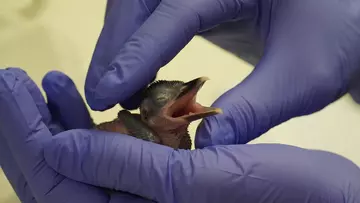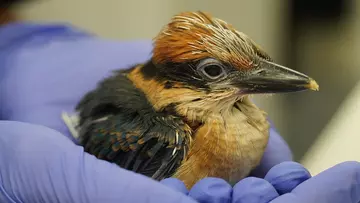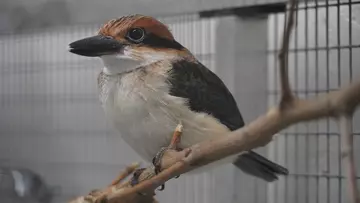
A zookeeper at Whipsnade Zoo has swapped the rolling Dunstable Downs for the USA to help a team of specialists' hand rear four Extinct in the Wild Guam kingfisher hatchlings - ahead of their release into the wild next year.

As part of the Sihek Recovery Project, bird keeper Claire McSweeney was sent by ZSL, the international conservation charity behind Whipsnade Zoo, to Sedgwick County Zoo in Kansas, because of her expertise in hand rearing threatened birds at the conservation zoo.
“I flew to America in early June and the next day the eggs started to hatch – since then it's been go, go, go,” said Claire. “We’ve been caring for the rare chicks around the clock, feeding, monitoring and weighing them to ensure they’re in the best of health,” Claire said.
“Apart from these four fluffy brown chicks. there are only 137 Guam kingfishers or sihek, as they are known to the CHamoru people, in the whole world. These little hatchlings are extremely precious as ZSL, and its partners work towards growing the population and introducing sihek back into the wild.”

Sihek (Todiramphus cinnamominus) are endemic to Guam, a small island in the North Pacific.
In the 1940s, the brown tree snake was accidently introduced to the island with devastating consequences, wiping out the sihek population along with other native birds, bats and lizards. The island is currently overrun with more than 2 million invasive brown tree snakes.
The fascinating birds - which will develop dusty orange feathers and striking blue wings once they reach adulthood - became Extinct in the Wild in 1988 - a classification designated by the IUCN meaning they are now only found in human care.
John Ewen Senior Research Fellow at ZSL’s Institute of Zoology and Sihek Recovery Team Chair said conservation zoos had done an incredible job in saving sihek from certain extinction and boosting the population but it was now time to take the next step.
“Without conservation zoos, species like the sihek wouldn’t exist. In the 1980s there were only a handful of sihek left in the world, now, thanks to expertise from zookeepers like Claire, there are 137 across the United States,” Dr Ewen said.

“Our goal is to continue to grow the bird's population and introduce the sihek into a predator free zone next year on the fully protected Palmyra Atoll: a temporary home where they can flourish in the wild before their hopeful return to a snake free Guam.”
The collaborative Sihek Recovery Project hopes to release nine chicks onto Palmyra Atoll next year, where they will be raised in aviaries until they are ready. This will be repeated annually until 20 sihek successfully establish as breeding pairs. They will then be tracked and monitored, before hopefully raising the first wild-born sihek chicks since the 1980s.
Claire said the team had gathered vital information about hand-rearing the sihek chicks, which will help the team as they move closer to the planned release next year.
“The chicks, which currently weigh around 50g, are currently enjoying a nutritious diet of mice, but in the forests of Palmyra Atoll they will have to learn to hunt and forage for everything from insects to geckos,” she explained.
“We’re training them to associate feeding time with a whistle, so that if they struggle settling in, our team on the ground can blow a whistle and the birds will know where to go to find food. We want to make sure they have the strongest possible start to their new lives and can flourish in their wild homes – preparations start now.”
Find out more and support ZSL’s world leading, collaborative science and conservation work or pay a visit to Whipsnade Zoo to see some of the other 11,000 animals, keepers like Claire are helping to care for at the conservation zoo. Every ticket supports ZSL’s vital work for wildlife.
